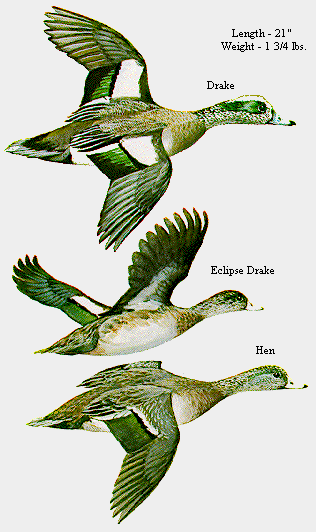

Identification Tips:
Length: 14 inches Wingspan: 34 inches
Large dabbling duck
Blue bill with black nail
White secondary coverts (grayer in females) and green speculum
White axillars
White belly
Juvenile similar to adult female
Adult male alternate:
Alternate plumage worn from fall through early summer
White crown
Green post-ocular stripe
Streaked gray lower face and neck
Rusty breast and flanks
Dark brown back
White patch at rear portion of flanks
Black undertail coverts
Adult male basic:
Similar to adult female but usually retains rusty flanks and white forewing
Adult female:
Blue bill with black tip
Mottled dark brown body plumage with rustier flanks contrasting with paler head and neck
Dusky eye patch
Similar species:
Adult in alternate plumage is unmistakable. All plumages distinguished from all other dabbling ducks (except Eurasian Wigeon) by pale gray or white secondary coverts in flight. At rest Wigeon have a distinctive steep forehead and gently sloped rear part of the head, as well as pale blue bills. The rare Eurasian Wigeon is very similar in female, immature and eclipse male plumages and is safely distinguished only in flight by its gray, not white, axillars, and sometimes by the lack of contrast between head and back plumage.

These are nervous birds, quick to take alarm. Their flight is fast, irregular, with many twists and turns. In a bunched flock, their movements have been compared to those of pigeons.

When open water is handy, wigeon often raft up offshore until late afternoon when they move to marshes and ponds to feed. The white belly and forewing are very showy in the air. Drakes whistle; hens have a loud kaow and a lower qua-awk.
